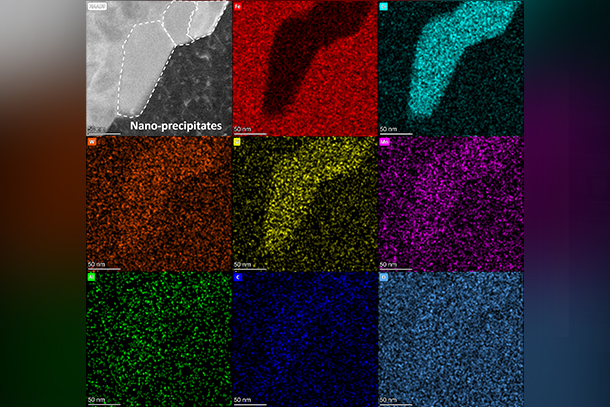
Xing Wang, assistant professor of nuclear engineering at Penn State, will use the award to improve materials used in advanced reactors. One approach he will pursue is optimizing nanosized precipitates — shown here — in steel to withstand higher temperatures. Credit: Provided by Xingyu Liu & Xing Wang/Penn State. All Rights Reserved.
Q&A: Xing Wang awarded DOE Distinguished Early Career Award
With the funding, Xing Wang aims to improve steel for use in nuclear reactors
August 8, 2023
By Ashley WennersHerron
UNIVERSITY PARK, Pa. — Xing Wang, assistant professor of nuclear engineering in the Penn State College of Engineering, was awarded a U.S. Department of Energy Office of Nuclear Energy’s Distinguished Early Career Award. He was one of five early career faculty employed at a U.S. university to receive the honor, which also included $625,000 to fund a five-year research project related to nuclear energy.
The award is facilitated through the Nuclear Energy University Program, which “invests in the innovative research and education programs of outstanding early career university faculty poised to pave new lines of inquiry and advance mission critical research directions in nuclear energy,” according to the program’s website.
Wang, who is also affiliated with the Intercollege Graduate Degree Program in Materials Science and Engineering in the Penn State College of Earth and Mineral Sciences, is focusing his project on improving the performance of materials potentially used in advanced nuclear reactors. The materials, called ferritic-martensitic steels, are highly thermally conductive and resistant to radiation, Wang said, making them a “promising” candidate for constructing nuclear reactors. But first, he added, they need to be engineered to withstand the high temperatures and corrosive coolants within advanced reactors.
Wang discussed the project more in depth, including how he plans to collaborate with other faculty and recruit students to contribute.
Q: What do you want to understand or solve through this project?
Wang: We aim to bolster the resistance of ferritic-martensitic steels against environmental degradation in advanced fission nuclear reactors. Specifically, we have two objectives. Firstly, we will enhance the steel's high-temperature strength by optimizing the internal precipitates, akin to gravel in concrete. Secondly, we aim to improve the steel's capacity to withstand corrosion by developing novel and protective coatings.
Q: What are ferritic-martensitic steels? Why is it important to improve their resistance to environmental degradation?
Wang: Ferritic-martensitic steels, also known as FM steels, are iron-based alloys containing a high concentration of chromium. FM steels have excellent thermal conductivity and exceptional radiation tolerance. Therefore, they are promising candidate materials to construct nuclear reactors. However, at elevated temperatures — more than 600 degrees Celsius — FM steels tend to lose their mechanical strength and react with corrosive media, such as molten salt. This susceptibility significantly curtails their applicability in advanced reactor designs, which are more reliable and efficient than the current nuclear fleet but also operate at higher temperatures.
Q: How do you hope this work will impact society?
Wang: Nuclear power is the leading carbon-free power source, but it is not perfect in its current state. My project and others’ work to advance materials, like FM steels, will enable the development of safer, more efficient, next-generation nuclear power plants, a potent source of low-carbon and high-capacity electricity which will play a key role in tackling climate change and ensuring energy security.
Q: Will you collaborate with others at Penn State on this project? Will undergraduate or graduate students contribute?
Wang: I plan to proactively solicit advice and support from our esteemed faculty members within both the nuclear engineering and material science and engineering departments. Over the course of this five-year project, our team will consist of one graduate research assistant (RA) and three undergraduate RAs, each of whom will play integral roles in advancing the work.
Q: The DOE award not only funds a research project, but it also recognizes the potential of the recipient as a researcher, educator and leader in their field. How do you hope to fulfill that potential?
Wang: Firstly, this project will enable me to introduce cutting-edge research areas, such as advanced microscopy and high-throughput material calculations, into my classroom, thereby attracting more talented students to the exciting field of nuclear materials. Secondly, the research associated with this project is highly interdisciplinary, leveraging Penn State's distinctive capabilities in both nuclear power and materials science. Lastly, the objectives of this project align closely with those of the Post-Industrial Midwest and Appalachia Nuclear Alliance, an initiative led by Penn State that aims to expedite the adoption of advanced nuclear power and facilitate the energy transition in the post-industrial Midwest and Appalachian regions. As such, this project not only augments scientific understanding but also has practical implications for regional development.



